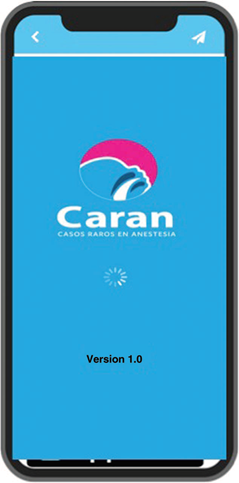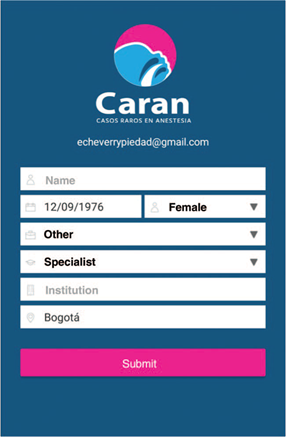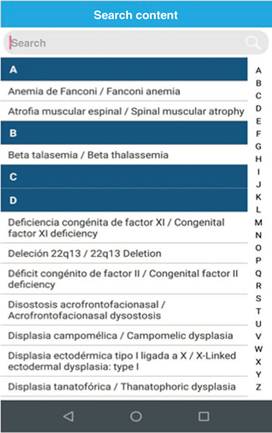Introduction
According to North American statistics, it is estimated that 8% of the population younger than 25 years old presents with some type of rare disease or genetic syndrome, versus 5% of the population above 25 years old.1 Nowadays we know a lot more about the pathophysiology of these diseases, their metabolic background and genetic origin, allowing for considerable progress in therapy and the classification and genetic counseling for patients and families. However, due to the low prevalence of these diseases, many healthcare professionals are not yet familiar with this type of patients. Unfortunately, there is still a big gap in the knowledge of these pathologies, placing the patient at risk because of failure to make an early diagnosis, and comprehensive management or proper rehabilitation are not provided to ensure an acceptable quality of life.
Over 6000 rare diseases have been described around the world, and in Colombia there is already a list of 1700 orphan diseases registered under the Ministry of Health, making it impossible to memorize each one of them.2 A comprehensive approach to these patients requires the advice of a multidisciplinary team, including pediatricians, endocrinologists, geneticists, orthopedists, general surgeons, intensive care practitioners, physiatrists, and rehabilitation specialists, in order to develop the best therapeutic plan. The central objective of comprehensive multidisciplinary care is to provide improved quality of life and a maximum reduction of perioperative morbidity and mortality, which are associated with a higher incidence of medical-surgical complications in this type of patients.
From the perspective of the anesthesiologist, infrequent diseases are indeed a group of very rare conditions that present occasionally, but with significant implications for the physiology and anatomy of the patients which represent a big challenge for perioperative management. These situations are not exclusive to pediatric anesthesiologists, but are certainly more frequent among this population.
The anesthetic implications of rare diseases or genetic syndromes are so diverse and frequently so complex, that they must be kept in mind when caring for patients. Some diseases are associated with malignant hyperthermia, others may present with crisis of rhabdomyolysis during the perioperative period, some have a high risk of malignant arrhythmias with exposure to anesthesia, and many have difficult airways or difficult venous access, resulting in a high risk of cardiorespiratory complications, a higher incidence of cardiac arrest, and adverse events that lead to higher mortality among this group of patients.3,4
Notwithstanding the abundance of information available in the medical literature, there is a shortage of information on orphan diseases; although there are books focusing on these syndromes5-7 and web pages describing the perioperative risks of these patients,8 the evidence is based on case reports and experiences of individual groups that have dealt with very complex patients with rare diseases.9,10 There are very few randomized controlled trials due to the low prevalence of these pathologies, which makes it almost impossible to conduct such trials. Therefore, the information available is difficult to filter and definitively finding relevant information about the anesthetic and perioperative management is usually impossible.
Moreover, the language barrier has also limited access to the available information, particularly for the Spanish-speaking population. Most of the information is in English, which hinders its understanding and comprehension fora large segment of Latin American practitioners.
With this background, a research project was undertaken aimed at developing an App for mobile devices that allows for looking up a list of genetic syndromes and of the most common orphan diseases that involve special considerations for anesthetic management. This is a learning opportunity for the Spanish-speaking community, since it provides in Spanish the most relevant, concise and appropriate information for the perioperative management of patients with rare syndromes or diseases that will undergo surgery, with the objective of ensuring safety and avoiding as much as possible any complications or adverse events that may result from exposure to anesthesia.
The study was initiated at the Instituto Roosevelt in Bogotá, a private, non-profit organization specialized in caring for pediatric and adult patients with orphan diseases, in order to provide them with comprehensive, multidisciplinary care for improving their quality of life and reintegrate them into society. The Colombian Society of Anesthesiology and Resuscitation (Sociedad Colombiana de Anestesiología y Reanimación-S.C.A.R.E.) supported the project and provided the necessary funds for its implementation, which was conducted under the supervision of the Research Committee.
Methodology
A final list of 120 diseases was selected from Resolution 430 of 2013 of the Ministry of Health and Social Protection, which classifies orphan diseases in Colombia. This list was developed by a medical geneticist who selected the diseases in accordance with their prevalence in our region, particularly those with major anesthetic implications.
The authors and collaborators conducted an academic review of the diseases, searching in Pubmed, Google Scholar, and the German Society of Anesthesiology webpage (orphananesthesia.eu); they selected the relevant full text articles on this subject matter in both Spanish and English, focusing on the publications over the last 10 years.
This information was used to populate the Excel database, containing the information about each disease, any synonyms, their definition, etiology, usual treatment, most usual surgical procedures, any dysfunctions due to systems involved, the most frequent perioperative risks, the pre-surgical examinations usually prescribed, and the anesthetic considerations described such as pre-surgical preparation, monitoring, induction of anesthesia, maintenance of anesthesia, sedation, regional anesthesia, extubation, postoperative care, and the major perioperative complications. Special mention was made of the most important warning signs and medications that are contra-indicated in some cases.
Media for Health (M4H) used the information collected by the authors to summarize it through an electronic application developed for mobile devices. Likewise, the design was completed and a name was chosen in agreement with the authors after several consensus meetings, during which the logo and the final colors of the App were adopted. The final testing for approval and publication over the iOS and Android platforms was conducted. The tests were administered by the authors and other anesthesiologists who were invited to surf and try the App from various mobile devices.
Results
The end result was the development of the CARAN App (Spanish acronym for Rare Cases in Anesthesia), which can be downloaded to mobile devices with iOS and Android operating systems all in Spanish. However, a short definition of the disease, warning signs, synonyms, and original name are also available in English.
The App may be downloaded at no cost from any of the following links:
IOS system: https://itunes.apple.com/co/app/caran/id1383546131?mt=8
Android system: https://play.google.com/store/apps/details?id=com.tactoapps.caran.desarrollo
We present here the first part of the project with includes the development of the App, its design and review of 60 orphan diseases. The second phase is expected to include new diseases (Fig. 1).
After downloading the App, the following user's profile information must be completed: e-mail, date of birth, sex, profession, institution, and location. This information shall be used as feedback to the authors and to register the number of downloads of the App, to discriminate the type of users and the cities or countries where the App is being used (Fig. 2).
There is also a paragraph with the terms and conditions developed by S.C.A.R.E. and Instituto Roosevelt, which describes how the information provided in each profile will be handled, and describing the information of the authors and the websites of the institutions responsible for the App. This information was drafted by S.C.A.R.E.'s legal department and includes a description of the rules of the Society for managing and protecting any personal information registered.
The CARAN App provides a start menu with the user's profile, any recent literature and a favorites section showing the diseases selected by each user. The contents include the diseases listed in alphabetical order, and a search bar that allows identification by name or synonym, as shown in Fig. 3.
Finally, the App provides detailed information about the anesthetic implications of the most important genetic syndromes and rare diseases requiring special anesthetic management, in order to ensure the safety of the perioperative patient.
The information provided for each disease, available in English and Spanish, is as follows: name of the syndrome or disease, brief description, and most relevant warning signs for perioperative management. This first part was developed to provide rapid and relevant information on the significance of each disease and the most important actions in terms of patient safety. These warning signs include a description of the medications that are contraindicated, the most important surgical or anesthetic risks, and any precautions to be adopted during the perioperative care of patients. Due to the importance of this information, the text is highlighted in red.
The additional information provided by the App includes:
Synonyms of each disease: this refers to the multiplicity of names given to one same disease; many of them are named after the authors that initially described the condition in the medical literature.
Definition: this is the complete and detailed description of the specific characteristics of each particular disease.
Etiology or origin: this section describes the main theories about the origin of the disease, the genes involved and the type of genetic predisposition involved.
Most frequent surgeries: a detailed description is offered of the most frequent surgical procedures that have been described and reported in the literature.
Usual treatment: This paragraph described the medical therapies proven effectiveness to stabilize the disease and control symptoms, or the enzyme or hormone replacement therapies. Many therapies are palliative and other are in their experimental stage, so their recommendation may change over time.
Associated alterations: this is a list of the malformations and organs affected, corresponding to each disease, separated by system.
Perioperative risks: this is a list of the most important anesthetic and surgical risks that may give rise to perioperative complications. Emphasis is made on the susceptibility to develop malignant hyperthermia, rhabdomyolysis triggered by anesthetic agents, difficult airway and cardiac and respiratory complications that may endanger the life of the patient.
Pre-surgical examinations: a list of the laboratory test and diagnostic studies recommended to be conducted before a surgical procedure was prepared; nevertheless, this recommendation is directly dependent on the patient's overall condition, the evolution of the disease, and the type of surgery planned. The treating physician's medical judgment determines the relevance of each pre-surgical examination. This particular section is just a guide recommending pre-operative tests in general.
Anesthetic implications: an individual description of the pre-surgical preparation is provided, together with monitoring, induction, and maintenance of anesthesia; any sedation-associated risks, the most significant considerations for extubation, and perioperative care. Each of these descriptions shall be considered in accordance with the patient's general condition, the underlying disease and the surgical procedure planned.
Finally, the most important considerations for regional anesthesia and the major postoperative complications are described, in addition to the bibliography supporting the information contained in each description.
Conclusion
The CARAN (Spanish Acronym for Rare Cases in Anesthesia) App is introduced as a research project in the area of innovation in anesthesia. This project combines the knowledge acquired through years of caring and following patients with rare diseases, with the current technological developments and the Apps for mobile devices, the outcome of which is a list of genetic syndromes and the complications of anesthesia during medical-surgical care, in order to ensure safety and reduce the perioperative complications in these patients.
The App is available for free downloading into both iOS and Android platforms. This is the first App available in Spanish to look up the anesthesia complications of orphan diseases and genetic syndromes. The first phase of the project contains 60 diseases, and the second phase is expected to include a few more.
Ethical responsibilities
Protection of persons and animals. The authors declare that no experiments were conducted in humans or animals in this research project.
Confidentiality of the information. The authors declare that no patient data are included in this article.
Right to privacy and informed consent. The authors declare that no patient data are reported in this article.
Presentations
This paper was submitted as a Poster at the Congress of the European Society of Pediatric Anesthesia (ESPA) and at the Second International Assembly of Pediatric Anesthesia (IAPA) in Brussels, Belgium, held from September 6 to 8, 2018 (www.eurospa.com).











 text in
text in 





